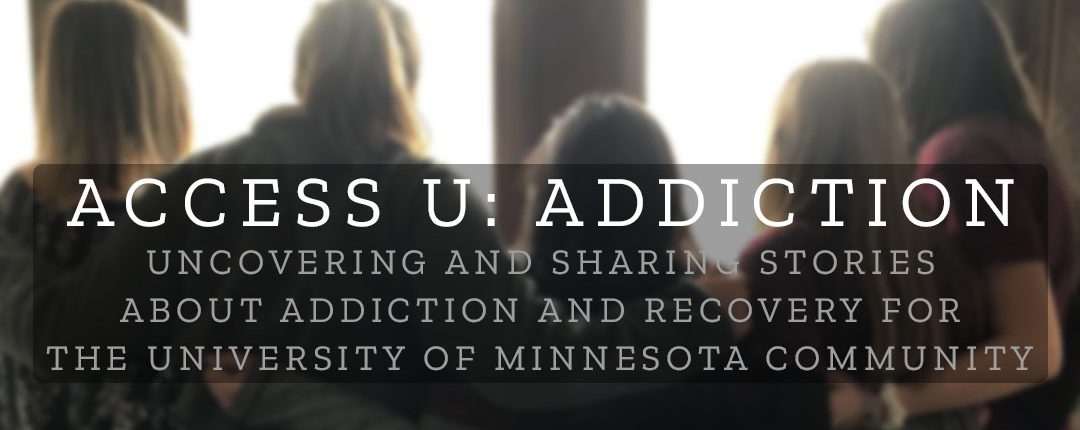By Kelsey Roy
A survey conducted by AccessU: Addiction shows a lack awareness about resources the University of Minnesota provides to students struggling with or recovering from addiction, even among those who would use the services.
The survey also suggests a need for those resources, either for students themselves or for those they know. About 40 percent of the more than 700 survey respondents say they are in recovery themselves or know someone who struggles with addiction, whether they have received treatment or not.
The survey, sent out via email in March to 5,000 randomly selected University of Minnesota-Twin Cities undergraduate students, set out to grasp students’ views about not only the university resources, but also the stigma and climate around drug and alcohol addiction on campus.
The questionnaire asked respondents to identify if they had ever sought treatment for drug or alcohol use or if they were still struggling with those substances. Students in that group – known as the “recovery group” – answered questions similar to those posed to a larger “non-recovery” majority of respondents who said they were not in recovery or struggling with substances.
The survey revealed that women identified stigma with addiction on campus more than men whether they struggle with the issue or not. That gender difference between men and women was greater among those who said they were in recovery or struggling – by as much as 20 percentage points – but was still present by 10 percentage points in the non-recovery group.
The survey also collected 116 comments, many of which raised concern about the culture of alcohol at the university and called for more candid conversation about addiction so that struggling students would not feel so isolated. The survey did not ask respondents to identify themselves.
“I think there are many students who are dependent on alcohol and use it to cope with stress but are in denial or scared of the issue and unaware because it’s easy to brush off as a regular part of college life or hard to recognize the difference,” wrote one respondent.
“We need to talk more,” wrote another respondent. “If we want to move toward solving substance use and abuse problems, we need to see the walking, waking reality that most people are functioning and most likely reframe their experiences to justify choices. Denial comes in shades.”
Respondents who have had, or thought about having, treatment report trouble socializing with other students and are unaware of resources.
The survey identified 58 students who said they were in recovery or “still struggling,” accounting for 8 percent of the total respondents.
Just under half of those students said the use of alcohol and drugs at social events makes it difficult for them to socialize with other university students.
For several years, the university has offered a social group called Students Off Booze Enjoying Recovery, or S.O.B.E.R., where students can meet each other and coordinate activities without alcohol. But the group was disbanded this semester because it lacks a student coordinator, and it has struggled for several years to sustain enough members, Boynton officials said.
The survey also asked students about how well overall university resources support students in recovery. Such resources might include drug and alcohol use assessments or limited counseling and referrals, which Boynton does provide, or community support groups or sober housing options, which the university does not.
The student respondents in the survey’s recovery group were decidedly mixed in their responses about whether the university provides adequate resources. Forty percent said they don’t know whether the university’s resources are adequate, compared with 32 percent who said those resources are enough.
Dave Golden, director for public health and communications at Boynton, said he believes the confusion comes from students not looking. “I think they haven’t given it a real shot as far as asking anyone ‘Hey I’m looking for help with alcohol addiction.’ If they asked almost anywhere on campus or even if they type it in, would you find it? Absolutely,” Golden said.
Ninety-two percent of respondents aren’t struggling with drugs or alcohol, but 40 percent know someone who is; those who do say university lacks adequate resources.
Most respondents to the survey said they have not sought treatment or are not struggling with addiction. Among that group, however, about 40 percent said they know at least one other person who is struggling with addiction.
Those who do know someone struggling with addiction were more inclined to say the university lacks resources to help those people.
Nearly 20 percent of students who know someone struggling said that the University does not offer the resources that recovering students need. By contrast, only 4 percent of those who don’t know anyone in that situation said that the University fails to offer adequate resources.
At the same time, the majority of all respondents also said the University should provide more help to students struggling with drugs and alcohol. Roughly 60 percent of both groups of students said that the university should provide more.
Among the ways respondents said the university could support students in recovery were student groups, therapy groups and sober living communities. Education, too, is one way to start, according to one respondent.
“Being the child of an addict, I know how these actions can impact people and their families LONG term,” wrote one respondent. “The culture around drinking and drugs needs to be changed, but I do believe that the university could put a lot more effort into education.”
